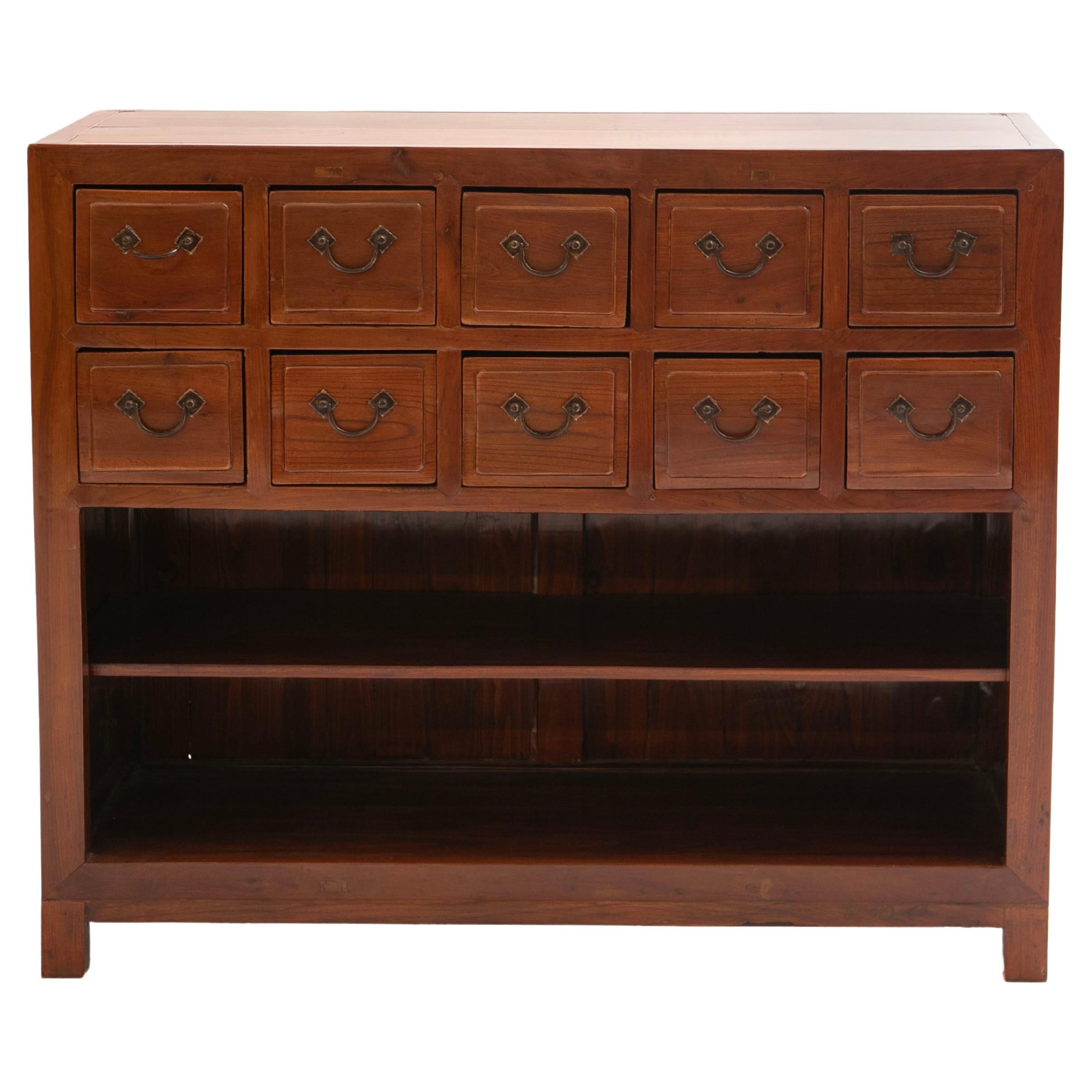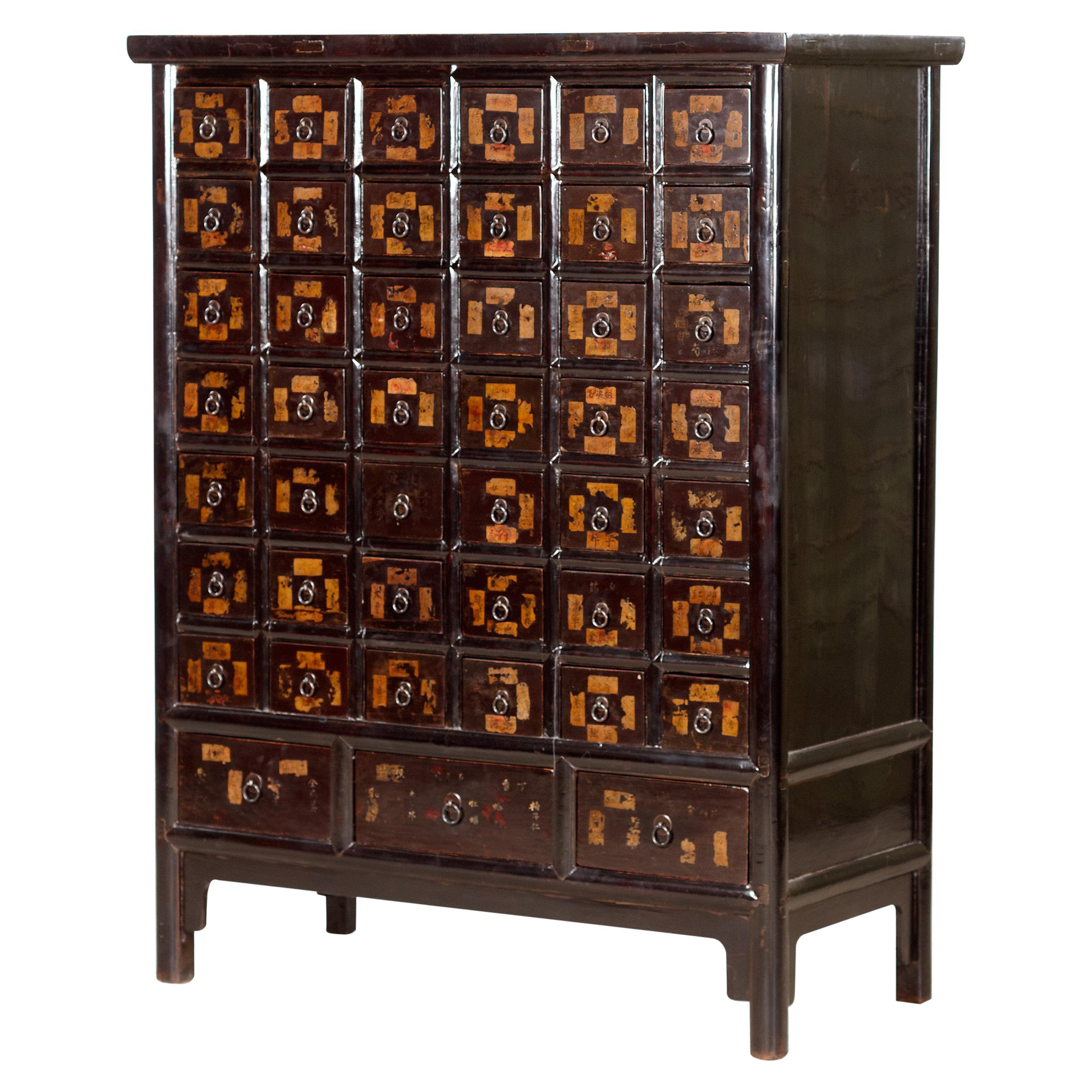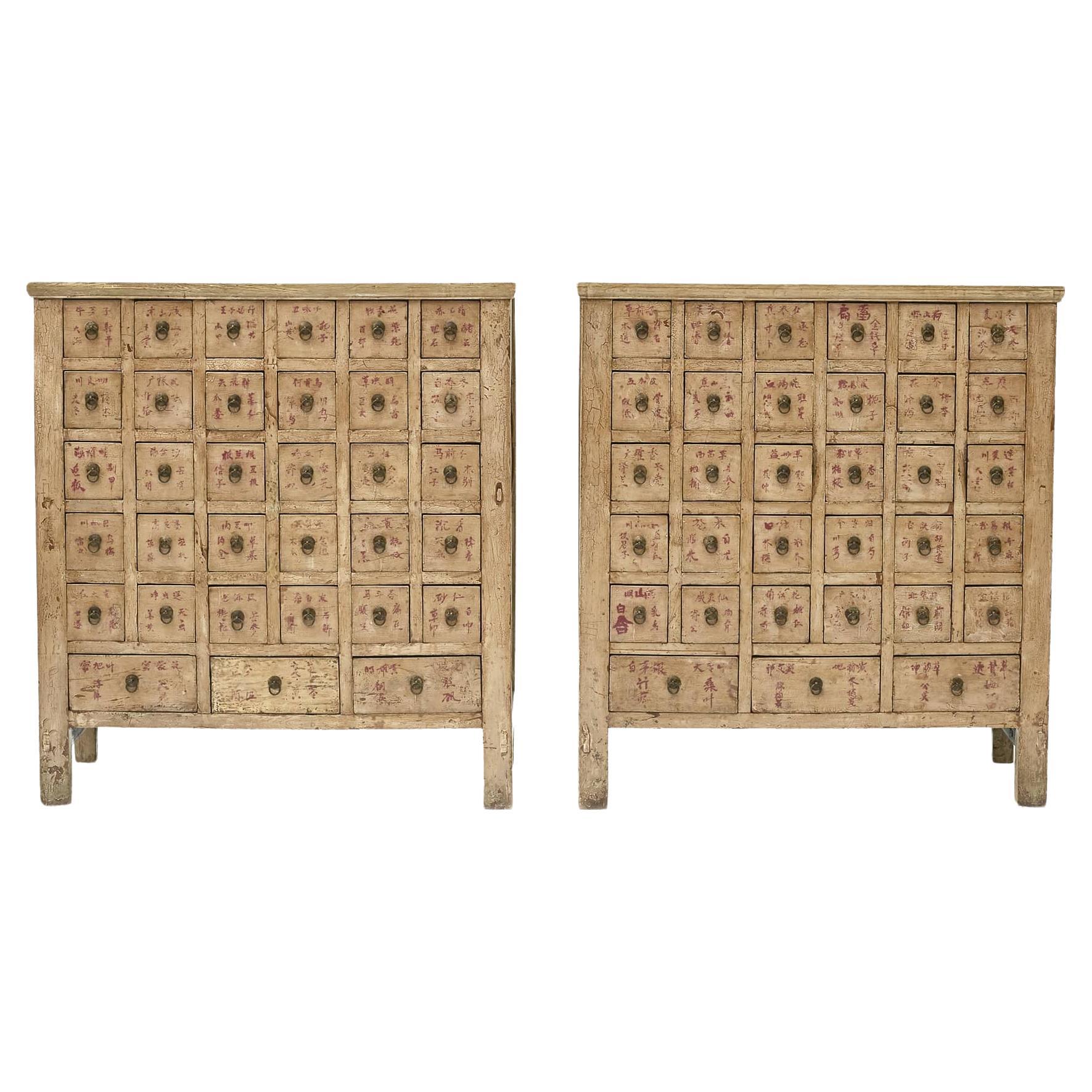Items Similar to Cassettone or Bureau-Chest, Late 16th Century, Italian Renaissance, Walnut
Want more images or videos?
Request additional images or videos from the seller
1 of 11
Cassettone or Bureau-Chest, Late 16th Century, Italian Renaissance, Walnut
About the Item
Exceptional museum quality, Italian, renaissance walnut cassettone with fitted bureau in the upper part & exceptional Bambocci carving, Lombardy.
This magnificent cassettone exudes the character and quality of the finest, late-Renaissance furniture. Late 16th century, Northern Italian furniture often had the sides, legs or angles, 'a Bambocci', incorporating carved figures which were unique sculptures in their own right. The putti on this cassettone are beautifully carved and of sculptural quality. Each angel has one arm raised to heaven, a poignant touch. Showing customary signs of wear from time, the lion’s paw feet make a great statement. This cassettone was conceived to have visual impact through the quality of the carving, as well as being very practical with the writing compartment fitted in the top part. It has survived in very original condition with a few small repairs and losses, and the color and patina are warm and lustrous. This cassettone was illustrated in one of the seminal works on Lombardy furniture in the 1969 and has been in two renowned collections.
The hinged top in two sections faced with a solid moulded edge. The front part has a fall front and opens to reveal a writing compartment. The fall front retains its original lock and is concealed with a false drawer which is above three drawers. All with moulded panels, escutcheons and retaining the original iron handles. The front ends have exceptional, bambocci, carved putti raising their arms to heaven above trailing foliage. Standing on magnificent lion's-head carved feet. The sides are panelled. Exceptional original colour and patina.
Provenance: Coll. Private Azzate The Collection of Sandro and Lidia Orsi, Ca’ Mera, Varese. Regarded as one of the most beautiful homes in Lombardy, Ca’ Mera, the country house of Sandro and Lidia Orsi was filled with beautiful objects from many different epochs. A renowned antiquarian from Milan, over his lifetime Sandro and his wife Lidia revived the Renaissance and Baroque character of the house and instilled their own unique vision into the interiors, which culminated with the creation of a Kunst – or Wunderkammer. “I have never seen such an example of poetical taste”, Sir John Pope-Hennessy said after visiting the Orsi house.
Literature: Illustrated in C. Alberici, Il Mobile Lombardo, Milan, 1969, p. 45.
A Gonzalez-Palacois, Il mobile in Liguria, Genova, 1996 illustrates related pieces.
- Dimensions:Height: 40.95 in (104 cm)Width: 58.27 in (148 cm)Depth: 29.53 in (75 cm)
- Style:Baroque (Of the Period)
- Materials and Techniques:
- Place of Origin:
- Period:
- Date of Manufacture:1585-1625
- Condition:
- Seller Location:BUNGAY, GB
- Reference Number:1stDibs: LU3867332754832
About the Seller
5.0
Vetted Seller
These experienced sellers undergo a comprehensive evaluation by our team of in-house experts.
Established in 1985
1stDibs seller since 2018
84 sales on 1stDibs
Typical response time: 9 hours
- ShippingRetrieving quote...Ships From: BUNGAY, United Kingdom
- Return PolicyA return for this item may be initiated within 7 days of delivery.
More From This SellerView All
- Cassettone Bureau-Chest Bambocci 16century Italian Renaissance Walnut LombardyLocated in BUNGAY, SUFFOLKAN EXCEPTIONAL MUSEUM QUALITY, ITALIAN, RENAISANCE WALNUT CASSETTONE WITH A FITTED BUREAU IN THE UPPER PART & EXCEPTIONAL BAMBOCCI CARVING, LOMBARDY - This exceptionally rare, museum quality, piece of early furniture was conceived and crafted as an artwork of the finest quality of its time. Throughout time it has been a luxurious, statement piece which has protected it, and fortunately it has survived in virtually, original condition. - This magnificent cassettone exudes the character and quality of the finest, late-Renaissance furniture. Northern Italian Renaissance furniture often had the sides, legs or angles, 'a Bambocci', incorporating carved figures which were considered unique sculptures in their own right. - The putti on this cassettone are beautifully carved and of sculptural quality. Each angel has one arm raised to heaven, a poignant touch. - The lion’s paw feet are a classical feature and make a great statement. - This cassettone was conceived to have visual impact through the quality of the carving, as well as being very practical with the writing compartment fitted in the top part. - It has survived in very original condition with a few small repairs and losses, and the colour and patina are warm and lustrous. - This cassettone is illustrated Illustrated in C. Alberici, Il Mobile Lombardo, Milan, 1969, p. 45, one of the seminal works on Lombardy furniture, and has been in two renowned collections. The hinged top in two sections faced with a solid moulded edge. The front part has a fall front and opens to reveal a writing compartment. The fall front retains its original lock and is concealed with a false drawer which is above three drawers. All with moulded panels, escutcheons and retaining the original iron handles. The front ends have exceptional, bambocci, carved putti raising their arms to heaven above trailing foliage. Standing on magnificent lion's-head carved feet. The sides are panelled. Exceptional original colour and patina. Literature : Illustrated in C. Alberici, Il Mobile Lombardo, Milan, 1969, p. 45. A Gonzalez-Palacois, Il mobile in Liguria, Genova, 1996 illustrates related pieces Measures: Length 147 ½ cm. 58 in, height 104 cm. 41 in, depth 75 cm. 29½ in, Provenance: Coll. Private Azzate The Collection of Sandro and Lidia Orsi, Ca’ Mera, Varese. Regarded as one of the most beautiful homes in Lombardy, Ca’ Mera, the country house of Sandro and Lidia Orsi was filled with beautiful objects from many different epochs. A renowned antiquarian from Milan, over his lifetime Sandro and his wife Lidia revived the Renaissance and Baroque character of the house and instilled their own unique vision into the interiors, which culminated with the creation of a Kunst – or Wunderkammer. “I have never seen such an example of poetical taste”, Sir John Pope...Category
Antique 16th Century Italian Renaissance Commodes and Chests of Drawers
MaterialsWalnut
- Cathedra or Throne Chair, Late 16th Century, French Second Renaissance, WalnutLocated in BUNGAY, SUFFOLKA moulded cornice sits above the high, panelled back with fluting and applied roundels. The later, metal pin on the left edge releases the central, moulded panel in the back which retains its original hinges. When the pin is removed the panel can be lowered, revealing a large area behind. The scroll arms are supported by tapering turnings which can be compared with mid-16th century benches of the nave such as those in the churches in Gerberoy and Coivrel which are in Oise, the Piccardie region of Frances. The panelled, box seat has later 18th century hinges...Category
Antique 16th Century French Renaissance Armchairs
MaterialsWalnut
- Table, Drawleaf, 18-Seat, 16th Century, Italian, Renaissance, Walnut, IronLocated in BUNGAY, SUFFOLKThis massive 18-seat table has many features which are typical of drawleaf tables that were made in the last quarter of the 16th century. Early continental drawleaf tables rarely com...Category
Antique 16th Century Italian Renaissance Dining Room Tables
MaterialsWalnut
- Pair of Walnut Armchairs, Late 16th Century, French Renaissance, with Ram Mask CLocated in BUNGAY, SUFFOLK"This rare pair of upholstered open armchairs relate to examples in museum collections in France, the USA and the UK. Few pieces of Renaissance furniture featuring ram’s head motif arm terminals survive as the chairs would have been in the ownership of the elite symbolising leadership and authority. The condition of these armchairs reflects their age and use and they have a rich colour and lustrous patina. The form of these chairs is characteristic of a stereotypical Renaissance model. The upholstered section of the backs are upholstered in wool with applied 17th century floral needlework faced with gilded studs and supported by square section uprights. The channelled tablet and stylised rosette incised curved arms terminate in acanthus capped carved rams' masks and are supported by column turned uprights headed by an entrelac collar. The ram is a symbol of leadership and authority and it also determination, action, initiative, and Aries, the first sign of the Zodiac. The seats are upholstered in wool with applied 17th century needlework faced with gilded studs and supported by tapering column/ring turned front legs and square section back legs. Some of the stretchers with moulded detailing. Standing on front ball feet. Exceptional original colour and patina. Henri II 1550-60. Condition: The chairs are both sturdy with exceptional colour and patina. One armchair with a splice on the rhs back leg and replaced but period front and lhs stretcher both bearing old nail marks, two other replaced stretchers and the back uprights bearing old nail marks indicating that they were upholstered at some point. The other armchair with an old repair to a break in the right back leg and an old patch near the end of the leg, replaced but period back and lhs stretcher, small patch to bottom of lhs arm where it meets the support. Old worm marks and some losses. Considering the age of the armchairs, these repairs and replacements are not unusual and consistent with the repairs on the related armchairs in museum collections. They suggest that the chairs either fell backwards at some point or someone leant back while sitting in them. Back Height 107cm, 42in, Seat Height 59.5cm, 23½in Width 60cm, 23½ in, Seat 59cm, 23¼in Depth including arm 59cm, 23¼in, Seat 49cm, 19¼in Provenance: Deaccessioned by The National Galleries of Scotland Bearing an old transport label from Alain Moatti (French architect) to Mrs Katz, London Literature: Related to : There are comparable armchairs in international museum collections dated to the second half of the 16th century. Most share the following characteristics with the above pair, the form, the ram's mask carved to the end of each arm, the curvilinear outline of the arm rests, the ring turned front legs as well as the plain square section back legs and plain stretchers. 1. Two stained glass windows...Category
Antique 16th Century French Renaissance Armchairs
MaterialsWalnut
- Chest or Stollentruhe, Early 16th Century, German Gothic, Oak Chest, OriginalLocated in BUNGAY, SUFFOLKThis standing chest is of clamp-front construction, extensively decorated with long, ironwork straps with quatrefoil finials which ‘wrap’ around it, and has an ornate, central lockplate, and front legs with full, height stiles. The ironwork straps and finials are fixed with convex, headed nails: running along the front, five long straps; the two side straps; and the five straps on the top. On the chest front, centrally placed, is a large, iron lockplate with four outer, radiating spade finals in each corner and three, superimposed spade finials (a symbol of nobility) which are pierced with the initials ‘BB’. The lockplate receives a corresponding, external hasp fitted to the lid. Below the floor of the chest, the two front stile legs retain most of their original height. The lid is supported by substantial iron strap hinges that extend right down the back of the chest. Inside the chest at the left end is a shallow, oak till. Construction The chest is of joined, 'clamp-front' construction, reinforced by the nailed, iron mounts. In total it uses ten, oak boards which were riven and planed. The back and front are each formed from a large single plank held to the full height stiles by long, pegged tenons. The sides are also single boards joined into the stiles using long tenons held by dowels, and extend down below the chest bottom, concealing the ends of the bottom boards. The bottom consists of a single board cut into the sides and shallow rebates in the stiles. The front and back boards are dowelled into the bottom boards. The lid which overhangs the sides has a narrow cleat at each end, and consists of one wide plank which has bowed a little as a result of shrinkage. Ironwork : The wrought ironwork straps, lockplate, hasp and lock all appear all appear to be early, and of the same original manufacture and are fixed with convex headed nails. There is mild dark staining of the oak around the iron mounts, possibly because of low tannin content in the oak. Length 172 cm., 67 ¾ in., Height 71.5 cm., 28 ¼ in., Depth 63 cm., 24 ¾ in., Related to: No 900:2-1904 V&A Museum, London. Stadtmuseum Dusseldorf. Decorative Arts Museum Berlin. Museen Schleswig-Holstein & Hamburg. A related example featuring elaborately-carved feet and formerly in the Horsham Museum, West Sussex, sold at Christie's in 2010 for £97,250 and another example, again with carved feet sold at Sothebys in 2006 for £48,000. Literature: A similar example is illustrated in H. Lüttgens, Alt- Aachener Wohnkultur; Ein Rundgang durch ein altes Aachener Haus im Wohnstil des 18. Jahrhunderts, Aachen, n.d., ill. 12, and another comparable iron-bound chests...Category
Antique 16th Century German Gothic Blanket Chests
MaterialsOak
- Commode, 18th Century, Italian, Venetian, Walnut, Small, Original BrasswareLocated in BUNGAY, SUFFOLKThis Classic 18th century model is a rare, small size with a rich color and lustrous patina. From a private collection, Semenzato, Venezia. Single plank top with solid moulded edge. The frieze with a band of gadrooned carving at the top. Below three drawers mouled with fine figuring original brass handles, escutcheon and locks only the top lock working. The pine drawers are lined with a block printed...Category
Antique Early 18th Century Italian Baroque Commodes and Chests of Drawers
MaterialsWalnut
You May Also Like
- Chinese Herbal Apothecary Chest, Late 19th CenturyLocated in Kastrup, DKA Chinese Qing Dynasty period late 19th century apothecary merchant's chest in Southern elm, also called Jumu wood. Originally used by a Chinese pharmacy to organize and store herbal...Category
Antique Late 19th Century Chinese Qing Furniture
MaterialsElm
- Japanese Meiji Period Late 19th Century Isho-Dansu Chest with Iron HardwareLocated in Yonkers, NYAn antique Japanese Meiji period two-part tansu chest from the late 19th century with dark red lacquer, iron hardware, small safe and carrying handles. Created in Japan during the Meiji period (1868-1912), this wooden chest called an Isho-Dansu chest is a fine example of Japan's traditional mobile cabinetry. Tansus were portable chests...Category
Antique Late 19th Century Japanese Meiji Commodes and Chests of Drawers
MaterialsIron
- 18th Century Chinese Medicine ChestLocated in Kastrup, DKMedicine Chest in original black lacquer. Shanxi province, China. Dating back from the late 18th Century.Category
Antique Late 18th Century Chinese Qing Commodes and Chests of Drawers
MaterialsMetal
- 19th Century French Parquetry Chest of DrawersLocated in Swindon, GBA 19th century French parquetry inlaid chest of drawers of small proportion, the marble top above three long graduated drawers, on scroll legs with ormolu mounts. with a working key....Category
Antique 1870s French Napoleon III Commodes and Chests of Drawers
MaterialsKingwood
- Early 20th Century Chinese Apothecary Medicine ChestsLocated in Kastrup, DKChinese apothecary / pharmacy medicine chests. Made of elm wood with ivory lacquer. Each with 33 drawers (30 small square drawers + 3 larger ). These were...Category
Antique Early 19th Century Chinese Qing Commodes and Chests of Drawers
MaterialsElm
- Early 20th Century Burmese Wood Chest of DrawersLocated in New York, NYA four-drawer chest in teak wood from old Burma, now Myanmar. Early 20th Century, circa 1925. Dark finish. Two small drawers, two large. Original brass handles.Category
Vintage 1920s Burmese British Colonial Commodes and Chests of Drawers
MaterialsTeak
Recently Viewed
View AllMore Ways To Browse
Italian Furniture Antique
Italian Antique Furniture
Antique Renaissance Furniture
Late Renaissance
Asian Faces
16th Italian
Antique Lifetime Furniture
Italy 16th Century
16th Century Italy
16th Century Italian
Carved Walnut Art
16th Century Italy Furniture
16th Century Italian Furniture
16th C
Carved Walnut Handles
16th Renaissance
16th Century Renaissance
16th Century Carved





